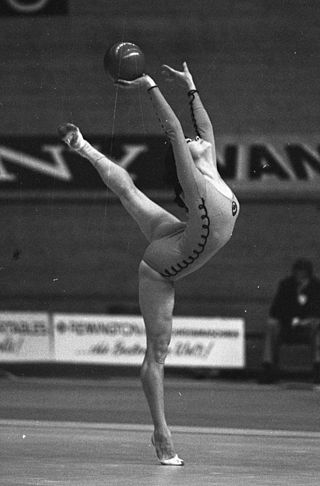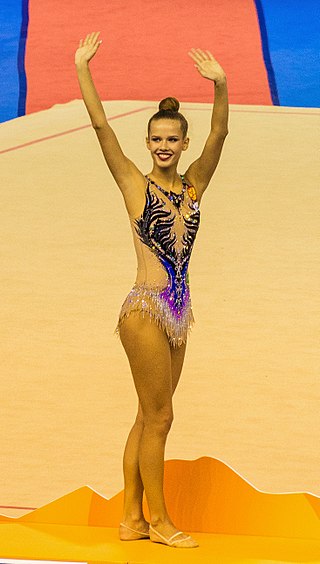
Gymnastics is a type of sport that includes physical exercises requiring balance, strength, flexibility, agility, coordination, and endurance. The movements involved in gymnastics contribute to the development of the arms, legs, shoulders, back, chest, and abdominal muscle groups. Gymnastics evolved from exercises used by the ancient Greeks that included skills for mounting and dismounting a horse, and from circus performance skills.

In gymnastics, the floor is a specially prepared exercise surface, which is considered an apparatus. It is used by both male and female gymnasts. The gymnastics event performed on the floor is called floor exercise. The English abbreviation for the event in gymnastics scoring is FX.

Aerobics is a form of physical exercise that combines rhythmic aerobic exercise with stretching and strength training routines with the goal of improving all elements of fitness. It is usually performed to music and may be practiced in a group setting led by an instructor, although it can be done solo and without musical accompaniment. With the goal of preventing illness and promoting physical fitness, practitioners perform various routines comprising a number of different dance-like exercises. Formal aerobics classes are divided into different levels of intensity and complexity and will have five components: warm-up, cardiovascular conditioning, muscular strength and conditioning, cool-down and stretching and flexibility. Aerobics classes may allow participants to select their level of participation according to their fitness level. Many gyms offer different types of aerobic classes. Each class is designed for a certain level of experience and taught by a certified instructor with a specialty area related to their particular class.

Calisthenics or callisthenics (/ˌkælɪsˈθɛnɪks/) is a form of strength training consisting of a variety of movements that exercise large muscle groups, such as standing, grasping, pushing, etc. These exercises are often performed rhythmically and with minimal equipment, as bodyweight exercises. They are intended to increase strength, fitness, and flexibility, through movements such as pulling, pushing, bending, jumping, or swinging, using one's body weight for resistance in pull-ups, push-ups, squats, etc. Calisthenics can provide the benefits of muscular and aerobic conditioning, in addition to improving psychomotor skills such as balance, agility, and coordination.

Rhythmic gymnastics is a sport in which gymnasts perform on a floor with an apparatus: hoop, ball, clubs, ribbon. The sport combines elements of gymnastics, dance and calisthenics; gymnasts must be strong, flexible, agile, dexterous and coordinated. Rhythmic gymnastics is governed by the International Gymnastics Federation (FIG), which first recognized it as a sport in 1963. It became an Olympic sport in 1984, with an individual all-around event. The group all-around competition was added to the Olympics in 1996. At the international level, rhythmic gymnastics is a women-only sport. The most prestigious competitions, besides the Olympic Games, are the World Championships, World Games, European Championships, European Games, the World Cup Series and the Grand Prix Series. Gymnasts are judged on their artistry, execution of skills, and difficulty of skills, for which they gain points. They perform leaps, balances, and rotations along with handling the apparatus.
Physical culture, also known as body culture, is a health and strength training movement that originated during the 19th century in Germany, the UK and the US.

Galima Akhmetkareevna Shugurova is a retired rhythmic gymnast who competed for the Soviet Union. She is the 1973 World All-around champion and two time World All-around silver medalist. She is the first All-around winner of the European Championships.

In rhythmic gymnastics, a gymnastics ribbon is an apparatus composed of a handle, a ribbon, and attachment, that is used during a floor performance.

Twirling is a form of object manipulation where an object is twirled by one or two hands, the fingers or by other parts of the body. Twirling practice manipulates the object in circular or near circular patterns. It can also be done indirectly by the use of another object or objects as in the case of devil stick manipulation where handsticks are used. Twirling is performed as a hobby, sport, exercise or performance.

Aerobic gymnastics or sport aerobics is a competitive sport originating from traditional aerobics in which complex, high-intensity movement patterns and elements of varying difficulty are performed to music.
Hooping is the manipulation of and artistic movement or dancing with a hoop. Hoops can be made of metal, wood, or plastic. Hooping combines technical moves and tricks with freestyle or technical dancing. Hooping can be practiced to or performed with music. In contrast to the classic toy hula hoop, modern hoopers use heavier and larger diameter hoops, and frequently rotate the hoop around parts of the body other than the waist, including the hips, chest, neck, shoulders, thighs, knees, arms, hands, thumbs, feet, and toes. The hoop can also be manipulated and rotated off the body as well. Modern hooping has been influenced by art forms such as rhythmic gymnastics, hip-hop, freestyle dance, fire performance, twirling, poi, and other dance and movement forms.
This is a general glossary of the terms used in the sport of gymnastics.

Evgeniya Olegovna Kanaeva OMF is a Russian individual rhythmic gymnast. She is the only individual rhythmic gymnast in history to win two Olympic all-around gold medals, winning at the 2008 Summer Olympics, where she finished with 3.75 points ahead of silver medalist Inna Zhukova, and at the 2012 Summer Olympics, where she also became the oldest gymnast to win the Olympic gold. On 4 July 2013, Kanaeva received the International Fair Play Award for "Sport and Life".
Gymnastics is a type of sport.

Yana Alexeyevna Kudryavtseva is a retired Russian individual rhythmic gymnast. She is the 2016 Olympic All-around silver medalist, three-time World Champion in the All-around (2013–2015), the 2015 European Games All-around champion, two-time European Championships All-around champion, the 2012 European Junior ball champion. In national level, she is a two-time Russian National All-around champion and three time Russian Junior National all-around champion.

Katsiaryna Aliaksandraŭna Halkina is a retired Belarusian individual rhythmic gymnast. She is the 2018 European all-around bronze medalist. She competed at the 2016 Summer Olympics in Rio, and finished 6th in the all-around final.
Salome Pazhava is a former Georgian individual rhythmic gymnast. She is Georgia's most successful rhythmic gymnast after Irina Gabashvili. She finished 4th in All-around at the 2015 World Championships.

Dina Alekseyevna Averina is a Russian individual rhythmic gymnast. She is the 2020 Olympic All-around silver medalist, the only four-time World All-around Champion, the 2018 silver and 2021 European All-around bronze medalist and the 2016 Grand Prix Final All-around silver medalist. On a National level, she is the 2017, 2018 and 2022 Russian National All-around champion and the 2013 Russian Junior All-around bronze medalist. Her identical twin sister, Arina Averina, is also a competitive rhythmic gymnast.

Ekaterina Sergeevna Selezneva is a Russian individual rhythmic gymnast. She is the hoop world champion in the Rhythmic Gymnastics World Championships 2019. She is also the 2018 Grand Prix Final All-around champion and the 2019 Summer Universiade All-Around gold medalist. On the national level, she is the 2018 Russian National all around bronze medalist.
Sagina Muratkyzy is a Kazakh rhythmic gymnast, member of the national group.














